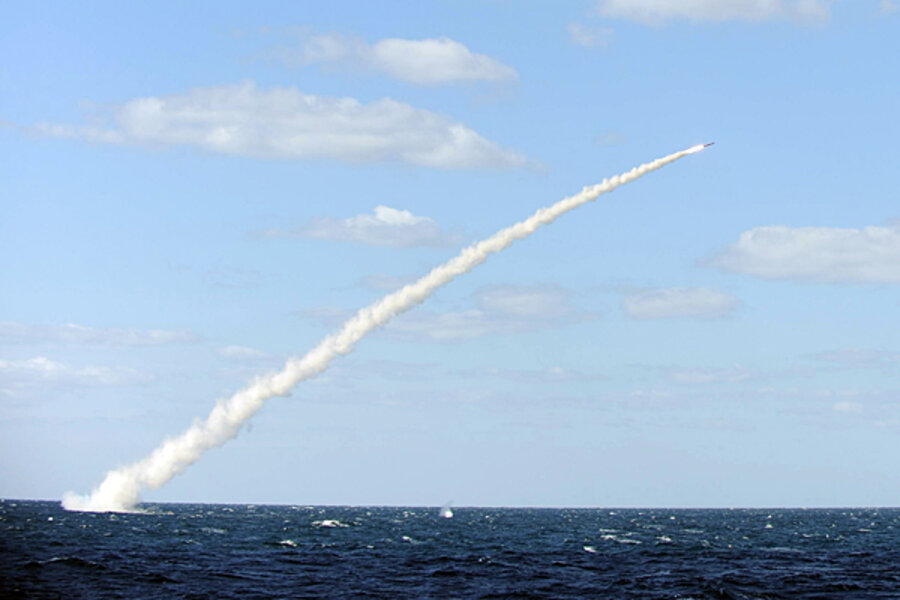Could North Korean missiles really hit US military bases?
Loading...
| Washington
Could North Korea hit US military bases in the Pacific region with missiles? The question arises because Pyongyang on Thursday threatened to do just that in retaliation for ongoing US-South Korea military training missions.
North Korea appears particularly unhappy about the participation of nuclear-capable B-52 bombers in these exercises. Washington dispatched these aircraft at a time of tension in the region to emphasize that the US remains committed to South Korea’s defense.
“The US should not forget that the Anderson Air Force Base on Guam, where B-52s take off, and naval bases in Japan proper and Okinawa, where nuclear-powered submarines are launched, are within the striking range of [North Korea’s] precision strike means,” a North Korean military spokesman told the KCNA state-run news service.
Is this within the realm of the possible? The short answer is “yes.” The longer answer is “yes, probably, they could try, but we’re not sure they could actually hit those targets, or with what, and they would be very foolish to attempt it.”
First, let’s look at the distances. Japan, home to about 38,000 US military personnel, is only about 650 miles from North Korea – not a very long flight. Guam, an island south of Japan and east of the Philippines, is much father at about 2,100 miles distance. (There are also upwards of 28,000 US servicemen and women based in South Korea itself.)
Japan is clearly within range of North Korean missile forces. Pyongyang’s medium-range Nodong 1, a single-stage liquid-propelled weapon based on Soviet “Scud” technology, could reach targets across the Japanese archipelago, according to an International Institute for Strategic Studies overview of North Korea’s missile program.
But the Nodong is not exactly a “precision strike” instrument, according to US analysts. It’s accurate only to within about two or three miles. Given its relatively small payload and the limited number North Korea has at its disposal, “the Nodong is probably more a political weapon than an effective military instrument,” the IISS concludes.
At 2,100 miles distance, Guam would be an even tougher target. It’s outside the range of Nodongs, but might be targeted by North Korea’s multi-stage intermediate range ballistic missile, the Taepodong, which has a 2,000-plus-mile range.
But as a 2012 Congressional Research Service study of Guam’s military defense notes, “there has been a question about whether North Korea deployed this IRBM.”
The Taepodong has been flight tested but once, and failed. South Korea in 2008 said the North had indeed deployed the weapon, but since then Pyongyang has shown yet another alleged medium-range missile, the Musudan, in a military parade.
“Presumably, Pyongyang has built or could assemble additional [Taepodong] missiles for firing on fairly short notice,” the IISS concludes.
Then there is North Korea’s long-range missile program. The Unha-3, to throw even more confusing designations into the mix, is a multi-stage rocket the North Koreans used to launch a satellite into space last December.
In theory, a ballistic missile based on the Unha would be able to deliver a nuclear warhead-sized payload as far as Alaska, Hawaii, or part of the lower 48 US states, according to an analysis from the Center for Nonproliferation Studies at the Monterey Institute of International Studies in California.
So there you have it. North Korea’s missile forces are either short-range, or little-tested, and even possibly non-existent. They could not do extensive damage unless tipped with nuclear warheads – and US intelligence believes Pyongyang does not have the ability to make miniature nukes. Yet.
And that’s the real problem. North Korea remains committed to improving its nuclear device capability and developing missiles that can threaten the rest of the world. It is already what the US and Israel worry Iran would like to become.
That’s why Secretary of Defense Chuck Hagel last week announced that in a time of fiscal austerity the US will devote $1 billion to adding 14 ground-based interceptors to US missile defenses based in Alaska.
At a hearing of the House Armed Services Committee on Wednesday a member of Congress asked Gen. Charles Jacoby, commander of US Northern Command and North American Aerospace Defense Command, whether he has been surprised by the fast development pace of the North Korean threat.
“I wouldn’t characterize it as being surprised,” said Gen. Jacoby. “I think that North Korea proceeded at a pace faster than we anticipated.”








